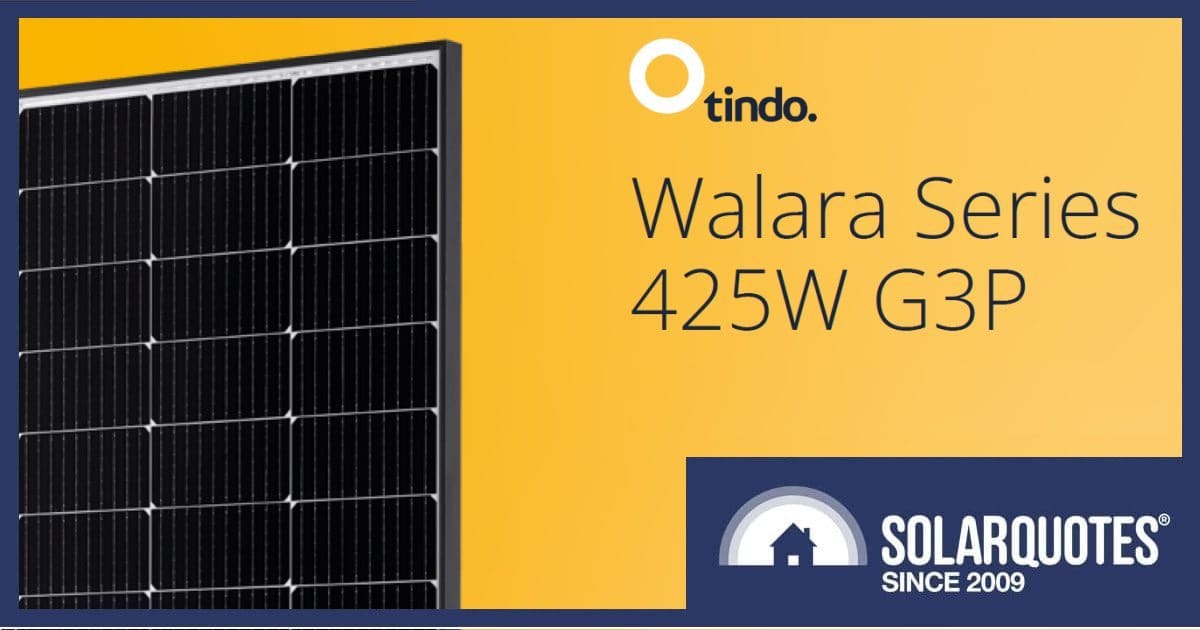
South Australian solar panel manufacturer Tindo Solar has taken the wraps off its 8th generation PV module – the Walara.
Manufactured at its facility in Adelaide, Tindo says the Walara series represents the first solar module featuring N-Type cells produced in Australia. The company states Walara will be produced in various cell configurations and variations including white-back, black-back and bi-facial. The first to be made available is the 425G3P, and the CEC approved modules list indicates (at this point) there will be at least 18 variations of the Walara series, in capacities from 415 Watts to 570 Watts.
Tindo Walara 425W G3P Specifications
- Cells: 108 half-cut N-Type
- Dimensions: 1722 x 1133 x 35 mm
- Panel Weight: 22 Kg
- Maximum Power: 425 Watts
- Positive power tolerance: 0 ~ + 5W
- Module efficiency: 21.8%
- Frame: Black anodised aluminium alloy
- Operating Temperature –40°C ~ +85°C
- Temperature Coefficient Pmax: –0.32 %/°C
- Product Warranty: 25 years
- Performance Warranty: 25 years (87.4% power at year 25)
A datasheet for the Walara 425WG3P can be accessed here.
Farewell Karra?
The Walara Series’ predecessor – the Karra – is no longer listed on the company’s website; but whether the arrival of Walara signals the immediate end of production of the Karra isn’t clear.
The Karra has served the company (and its customers) well. An example installation is a 5.5kW Karra based system that has been working away under harsh conditions at the Desert Knowledge Australia Solar Centre (DKASC) in Alice Springs since 2016. The DKASC is a demonstration facility for a range of solar technologies operating in an arid environment.
Other Tindo Happenings
Founded in 2010, Tindo manufactures panels using imported cells and other components. But the firm has its sights set on incorporating more Australian manufactured bits ‘n bobs. The company recently announced an agreement with the country’s largest aluminium extruder, Capral Aluminium, for the supply of module frame materials that will be used for the Walara 425W panel (and other Walara modules I assume). The company will be supplying Tindo with Capral’s “LoCAl” lower-emissions extruded product.
Tindo also intends building a new factory capable of producing up to 1 gigawatt (GW) of panels per annum (~7,000 panels per day). The firm has already signalled it will be applying for funding under the Federal Government’s $1 billion Solar Sunshot initiative, which seeks to support Australian solar PV and related manufacturing. The first funding rounds of Solar Sunshot kicked off on the weekend.
In 2022, Tindo expanded manufacturing at its Mawson Lakes, SA location; boosting annual production capabilities from 60 megawatts to 150 megawatts. The new gigafactory, assuming it goes ahead, will be built elsewhere. Tindo estimates the gigafactory will create 250 direct jobs and 900 supply chain jobs, and generate economic activity of around $300 million per annum.
While pricey compared to Chinese imports, Tindo has enjoyed support from Australians keen to buy quality, locally made panels. And on that front, it’s currently the only show in town. Tindo solar panel reviews here on SolarQuotes have averaged 4.7 stars overall and 4.5 stars over the last twelve months.
The company is currently listed as a SQ recommended solar panel brand. You can compare Walara specifications with other modules on SQ’s solar panel comparison table.

 RSS - Posts
RSS - Posts



Can you mix Karra P Type panels with Walara N Type panels in the same string, thanks ?
Hi David,
Roughly speaking you can mix any panels in a string but they’ll only really perform as well as the worst one.
I haven’t looked at the specs to plot a performance curve or temperature coefficient, but provided the maximum power voltage (VMP) and maximum power current (IMP) figures are within 5% you would probably do alright.